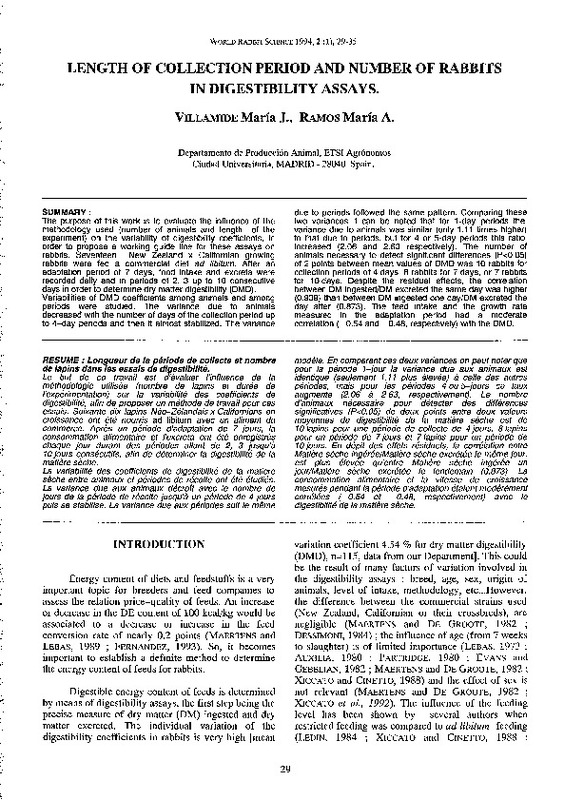JavaScript is disabled for your browser. Some features of this site may not work without it.
Buscar en RiuNet
Listar
Mi cuenta
Estadísticas
Ayuda RiuNet
Admin. UPV
LENGTH OF COLLECTION PERIOD AND NUMBER OF RABBITS IN DIGESTIBILITY ASSAYS
Mostrar el registro sencillo del ítem
Ficheros en el ítem
| dc.contributor.author | Villamide, M.
|
|
| dc.contributor.author | Ramos, M.
|
|
| dc.date.accessioned | 2011-03-23T11:36:17Z | |
| dc.date.available | 2011-03-23T11:36:17Z | |
| dc.date.issued | 1994 | |
| dc.identifier.issn | 1257-5011 | |
| dc.identifier.uri | http://hdl.handle.net/10251/10548 | |
| dc.description.abstract | [EN] The purpose of this work is to evaluate the influence of the methodology used (number of animals and length of the experiment) on the variability of digestibility coefficients, in order to propose a working guide line for these assays on rabbits. Seventeen New Zealand x Californian growing rabbits were fed a commercial diet ad libitum. After an adaptation period of 7 days, food intake and excreta were recordad daily and in periods of 2, 3 up to 1 O consecutiva days in order to determine dry matter digestibility (DMD). Variabilities of DMD coefficients among animals and among periods were studied. The variance due to animals decreased with the number of days of the collection period up to 4-day periods and then it almost stabilized. The variance due to periods followed the same pattern. Comparing these two variances it can be noted that for 1-day periods the variance due to animals was similar (only 1.11 times higher) to that due to periods, but for 4 or 5-day periods this ratio increased (2.06 and 2.63 respectively). The number of animals necessary to detect significant differences (P<0.05) of 2 points between mean values of DMD was 1 O rabbits for collection periods of 4 days, 8 rabbits for 7 days, or 7 rabbits for 1 O days. Despite the residual effects, the correlation between DM ingested/DM excretad the same day was higher (0.939) than between DM ingested one day/DM excretad the day after (0.873). The feed intake and the growth rate measured in the adaptation period had a moderate correlation (- 0.54 and - 0.48, respectively) with the DMD. | es_ES |
| dc.description.abstract | [FR] Le but de ce travail est d'évaluer l'influence de la méthodologie utilisée (nombre de lapins et durée de l'expérimentation) sur la variabilité des coefficients de digestibilité, afín de proposer un méthode de travail pour ces essais. Soixante dix lapins Néo-Zélandais x Californiens en croissance ont été nourris ad libitum avec un aliment du commerce. Apres un période d'adaptation de 7 jours, la consommation alimentaire et /'excreta ont été enregistrés chaque jour durant des périodes allant de 2, 3 jusqu'a 10 jours consécutifs, afin de déterminer la digestibilité de la matiere seche. La variabilité des coefficients de digestibilité de la matiere seche entre animaux et périodes de récolte ont été étudiés. La variance due aux animaux décroit avec le nombre de jours de la période de récolte jusqu'a un période de 4 jours puis se stabilise. La variance due aux périodes suit le meme modele. En comparant ces deux variances on peut noter que pour la période 1-jour la variance due aux animaux est identique (seulement 1. 11 plus élevée) a ce/le des autres périodes, mais pour les périodes 4 ou 5-jours ce taux augmente (2.06 a 2.63, respectivement). Le nombre d'animaux nécessaire pour détecter des différences significatives (P<0.05) de deux points entre deux valeurs moyennes de digestibilité de la matiere seche est de 1 O lapins pour une période de collecte de 4 jours, 8 lapins pour un période de 7 jours et 7 lapins pour un période de 1 O jours. En dépit des effets résiduels, la corrélation entre Matiere seche inpérée/Matiere seche excrétée le meme jour, est plus élevee qu'entre Matiere seche ingérée un jour/Matiere seche excrétée le lendemain (0.873). La consommation alimentaire et la vitesse de croissance mesurés pendant la période d'adaptation étaient modérément corrélées (- 0.54 et - 0.48, respectivement) avec le digestibilité de la matiere seche. | |
| dc.description.sponsorship | Financial support was provided by the "Comisión Interministerial de Ciencia y Tecnología" (GAN 90-83) | |
| dc.language | Inglés | es_ES |
| dc.publisher | World Rabbit Science. ICTA. UPV | es_ES |
| dc.relation.ispartof | World Rabbit Science | |
| dc.rights | Reserva de todos los derechos | es_ES |
| dc.title | LENGTH OF COLLECTION PERIOD AND NUMBER OF RABBITS IN DIGESTIBILITY ASSAYS | es_ES |
| dc.type | Artículo | es_ES |
| dc.date.updated | 2011-03-23T11:25:11Z | |
| dc.identifier.doi | 10.4995/wrs.1994.215 | |
| dc.relation.projectID | info:eu-repo/grantAgreement/MEC//GAN90-83/ | |
| dc.rights.accessRights | Abierto | es_ES |
| dc.description.bibliographicCitation | Villamide, M.; Ramos, M. (1994). LENGTH OF COLLECTION PERIOD AND NUMBER OF RABBITS IN DIGESTIBILITY ASSAYS. World Rabbit Science. 2(1):29-35. https://doi.org/10.4995/wrs.1994.215 | es_ES |
| dc.description.accrualMethod | SWORD | es_ES |
| dc.relation.publisherversion | https://doi.org/10.4995/wrs.1994.215 | |
| dc.description.upvformatpinicio | 29 | |
| dc.description.upvformatpfin | 35 | |
| dc.description.volume | 2 | |
| dc.description.issue | 1 | |
| dc.identifier.eissn | 1989-8886 | es_ES |
| dc.contributor.funder | Ministerio de Educación y Ciencia | es_ES |








